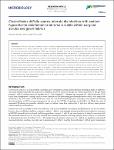Clostridioides difficile spores tolerate disinfection with sodium hypochlorite disinfectant and remain viable within surgical scrubs and gown fabrics
| dc.contributor.author | Ahmed, H | |
| dc.contributor.author | Joshi, LT | |
| dc.date.accessioned | 2023-11-22T17:30:12Z | |
| dc.date.available | 2023-11-22T17:30:12Z | |
| dc.date.issued | 2023-11-21 | |
| dc.identifier.issn | 1465-2080 | |
| dc.identifier.issn | 1465-2080 | |
| dc.identifier.other | ARTN 001418 | |
| dc.identifier.uri | https://pearl.plymouth.ac.uk/handle/10026.1/21678 | |
| dc.description.abstract |
Clostridioides difficile is the most common cause of antibiotic-associated diarrhoea globally. Its spores have been implicated in the prevalence of C. difficile infection due to their resistance and transmission ability between surfaces. Currently, disinfectants such as chlorine-releasing agents (CRAs) and hydrogen peroxide are used to decontaminate and reduce the incidence of infections in clinical environments. Our previous research demonstrated the ability of C. difficile spores to survive exposure to recommended concentrations of sodium dichloroisocyanurate in liquid form and within personal protective fabrics such as surgical gowns; however, the present study examined the spore response to clinical in-use concentrations of sodium hypochlorite. Spores were exposed to a 10 min contact time of 1000, 5000 and 10 000 p.p.m. sodium hypochlorite, and spore recovery was determined. To understand whether biocide-exposed spores transmitted across clinical surfaces in vitro, biocide-exposed spores were spiked onto surgical scrubs and patient gowns and recovery was determined by a plate transfer assay. Scanning electron microscopy was used to establish if there were any morphological changes to the outer spore coat. The results revealed that viable biocide-exposed C. difficile spores can be recovered from surgical scrubs and patient gowns, with no observable changes to spore morphology, highlighting the potential of these fabrics as vectors of spore transmission. This study demonstrates that alternative strategies should be urgently sought to disinfect C. difficile spores to break the chain of transmission in clinical environments. | |
| dc.format.extent | 001418- | |
| dc.format.medium | ||
| dc.language | en | |
| dc.publisher | Microbiology Society | |
| dc.subject | biocide | |
| dc.subject | disinfectant | |
| dc.subject | tolerance | |
| dc.subject | spores | |
| dc.subject | Clostridioides difficile | |
| dc.subject | transmission. | |
| dc.title | Clostridioides difficile spores tolerate disinfection with sodium hypochlorite disinfectant and remain viable within surgical scrubs and gown fabrics | |
| dc.type | journal-article | |
| dc.type | Article | |
| plymouth.author-url | https://www.ncbi.nlm.nih.gov/pubmed/37988292 | |
| plymouth.issue | 11 | |
| plymouth.volume | 169 | |
| plymouth.publication-status | Published | |
| plymouth.journal | Microbiology | |
| dc.identifier.doi | 10.1099/mic.0.001418 | |
| plymouth.organisational-group | |Plymouth | |
| plymouth.organisational-group | |Plymouth|Faculty of Health | |
| plymouth.organisational-group | |Plymouth|REF 2021 Researchers by UoA | |
| plymouth.organisational-group | |Plymouth|Users by role | |
| plymouth.organisational-group | |Plymouth|Users by role|Academics | |
| plymouth.organisational-group | |Plymouth|REF 2021 Researchers by UoA|UoA01 Clinical Medicine | |
| plymouth.organisational-group | |Plymouth|Faculty of Health|Peninsula Dental School | |
| plymouth.organisational-group | |Plymouth|REF 2028 Researchers by UoA | |
| plymouth.organisational-group | |Plymouth|REF 2028 Researchers by UoA|UoA01 Clinical Medicine | |
| dc.publisher.place | England | |
| dcterms.dateAccepted | 2023-11-07 | |
| dc.date.updated | 2023-11-22T17:30:12Z | |
| dc.rights.embargodate | 2023-11-25 | |
| dc.identifier.eissn | 1465-2080 | |
| rioxxterms.versionofrecord | 10.1099/mic.0.001418 |


